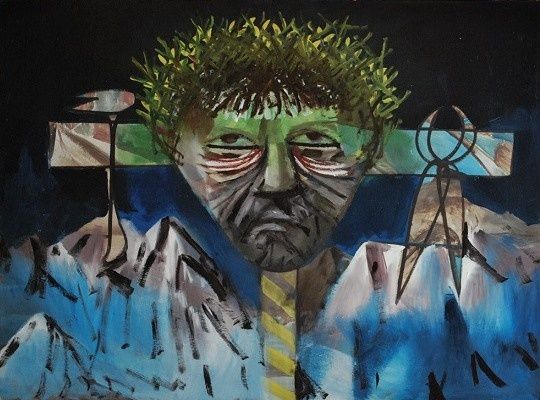

Crucifixion, 1955
Sidney Nolan, Crucifixion, 1955, 92.5 x 122 cm, Ripolin and oil on hardboard, private collection, © Sidney Nolan Trust
Rod Bugg is a practising artist and Emeritus Professor of the University of Arts, London. Until December 2006 he was Principal and CEO of Wimbledon School of Art, London. He is a former Trustee of the Sidney Nolan Trust.
“How difficult it is to select just a single work by Sidney Nolan from a body of work that is so extensive and wonderfully rich. My choice was triggered by a conversation with Lady Nolan when I was lead artist on the sculpture programme at The Rodd. She talked about her travels with Sidney and showed me her photographs of the Tuscan olive harvest from that time. She also spoke of Sidney’s earlier travels in the Mediterranean in both Italy and Greece and this fired my curiosity.
When you look at the paintings that draw on those journeys you become aware that, even though he was not a religious man, Nolan must have been deeply struck by the spirituality that pervaded the countryside and the way of life of Southern Europe. I also became curious about a crucifix with all of its strange attachments that sits in one corner of his Rodd studio and wondered whether this was acquired during his Italian or Greek travels? I was interested to find more than five crucifixion paintings from the early fifties, all overlaid with the black linear tools of the crucifixion and the face of Christ. Could these paintings draw on just such primitive southern crucifixes? They certainly reveal his extraordinary intellectual and visual curiosity about religions and cultures. In the same way that the primitive crucifix is encrusted with symbols and messages, these works also include the instruments of the passion which feature so strongly in the Orthodox and Catholic churches, particularly in the South - the dice cast by the soldiers, the crowing cockerel, the hammer, the pliers, the lance and the sponge and so on.
I eventually chose Crucifixion 1955, shown quite recently at The Rodd. Could it be that the painting overlays aspects of a Southern Mediterranean depiction of Christ and the crown of thorns with references to the Green Man of pre-Christian Northern Europe? Could the mask-like quality of the face of Christ be a reference to the mask of Ned Kelly set in the Italian/Greek landscape and mountains? Could it also be a deeply troubled portrait, and of whom? Maybe himself? Whilst being moved by the brutal image of the painting and the extraordinary quality of its execution there are also questions of what lies beneath the paint, what has been overpainted? What other painting hides below the surface of this particular crucifixion?
This painting is as powerful, dark and beautiful as it is complex. It leaves me with so many questions, as well as the enduring force of its presence.”